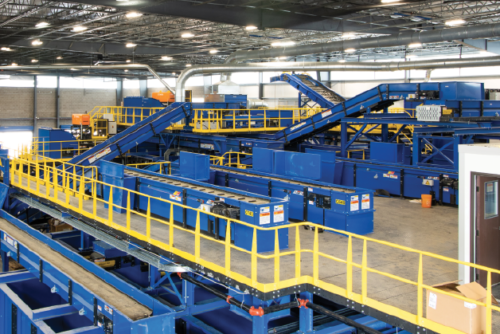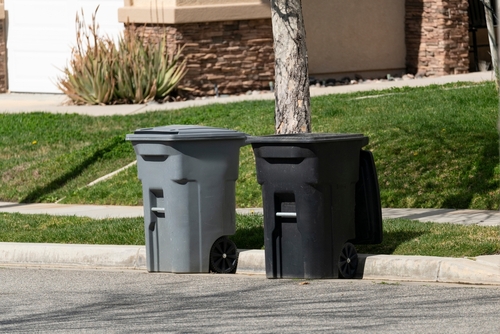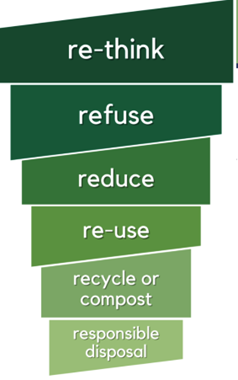Mar 17, 2025 | Community, Education, News

On July 1 of this year, Oregon will become the first state in the U.S. to launch a new recycling plan that will:
- expand the number of things most of us can recycle,
- provide residential recycling pickup service to city and rural customers in all parts of the state,
- require owners and managers of multi-unit housing to provide recycling for residents,
- improve public education about recycling,
- require certification of recycling operations to verify that their products are really being recycled,
- enable upgrades to the facilities that process recycled materials, and
- require producers of plastic and paper products to form a Producer Cooperative through which they will pay part of the cost of recycling, enough to provide funding to enable recycling facilities to upgrade equipment and make up for fluctuations in market prices,
- spur changes in packaging as manufacturers discover that making packaging easy to recycle saves them money.
For collectors, materials recycling facilities, final processors and especially manufacturers of plastic packaging and tableware, that means quite a change is coming. This bill will require manufacturers to share the cost of recycling plastics and paper products as well as help support and stabilize the recycling markets.
In 2021, the Oregon Legislature passed the law that created this change (SB 582), officially named the Plastic Pollution and Recycling Modernization Act. Oregon was the first state that addressed the issue. Since then, four others have signed packaging Extender Producer Responsibility (EPR) bills into law—Maine, Colorado, California and Minnesota. The law required the Department of Environmental Quality (DEQ) to draft rules to implement it by 2024. DEQ met that deadline, and since then it has been soliciting comments from the participants to ensure that the rules would be practical and that the companies affected by the bill would be able to comply.
Now DEQ has set the date when the new law will take effect: July 1, 2025.
In compliance with the new law, manufacturers that produce $5 million or more worth of paper, packaging and food serviceware have formed their Producer Responsibility Organization in Oregon called the CAA. Manufacturers will pay into the CAA, which will distribute the funds to the Materials Recovery Facilities and end recyclers to pay for upgrades to their equipment, which they will need to ensure the material they sell back to recycling process plants is clean, uniform and free of dirt, grease or food particles that would contaminate it and prevent recycling.
To understand how important this new system is, it helps to trace the path of the things we place in our curbside bins through their journey to becoming new products. Republic Services picks up our bins from the cans we place in front of our homes and takes the contents to a recovery facility (MRF) on Swan Island run by a company called EFI. EFI buys the mixed material that we put in our cans from Republic, separates them into newsprint, office paper, corrugated cardboard (OCC), milk and soup boxes, glass bottles, plastic bottles and batteries.
Once the items are separated, EFI sells each material to a different recycling plant, such as a local cardboard mill, the mixer that breaks down milk cartons or the big plastic pellet manufacturers in the midwest and east coast. At each of those buy-sell points, prices vary according to several factors, among them the cleanliness of the goods, supply and demand for them and uniformity over a group of loads.
Oregon’s new law will boost recycling work around the state by ensuring that separation facilities like EFI and Pioneer, who buy the recycled material we place in our cans, can sell their separated products on the market, regardless of price fluctuations. Under the new law and with their new equipment, separation yards such as EFI and Pioneer will be able to meet the standards of their customers, who often refuse shipments of separated materials because they are too dirty to process or don’t meet other specifications.
Summary of the Law
The act requires producers with annual sales of $5 million or more to form a Producer Responsibility Organization (PRO) that will fund improvements to the system and ensure the recyclables that are collected go to responsible end markets.
The producer responsibility organization (the CAA in Oregon) will use producer membership fees to ensure better and expanded recycling services. It will also fund waste prevention grants and studies to assess challenges and recommend solutions to improve recycling in condos and apartment complexes, equity in the recycling system, as well as clean up litter and marine debris.
The State of Oregon will establish one statewide list of what can be recycled by the franchised garbage haulers like Republic so that individuals and businesses can recycle the same items everywhere in the state.
Local governments, especially in rural areas, will expand their recycling services with direction and support from the PRO, and cities will do the same for people living in apartments and condos. The same private collection companies (i.e., garbage haulers) will continue to provide curbside pickup for recycling in cities where they already do that – including in Lake Oswego.
PRO(s) will create accessible educational resources that local governments can use to discourage contamination and encourage recycling
Processing of recyclable materials will be done in facilities that meet new performance standards, including material quality, reporting and paying living wages to facility workers. These facilities will be required to obtain permits from DEQ or meet similar standards before they can receive recyclable material from Oregon communities.
End markets that can handle the material appropriately – without creating plastic pollution – can purchase the materials that these facilities process and recycle them into new products. Producers will be obligated to make sure materials collected in Oregon reach responsible end markets.
Oversight and Integration
A new governor-appointed advisory council will provide feedback to DEQ and the PRO(s) about important elements of this new recycling system, including the statewide collection list. DEQ will oversee the recycling system and provide enforcement where necessary. The PRO(s), processors and local governments will track and report more and better information about where our recyclables go and provide assurance that they are used to make new products.
Mar 13, 2025 | Community, Education, News

By Susan Mead, LOSN Volunteer
The Lake Oswego garbage, recycling and yard debris with food waste rates have increased as of February 2025. The new rates are available to review at the city’s website: https://www.ci.oswego.or.us/recycle/garbage
There are several ways you can lower your monthly cost and take advantage of free services:
- If you have weekly service for a 65-gallon or 90-gallon trash roll cart and do not fill it more than half full every week.
SOLUTION: Consider going to a smaller roll cart from what you currently have. A 35-gallon trash roll cart service is almost 50% cheaper than the two largest sizes.
- If you have weekly service for the smallest roll cart (35-gallon) and usually don’t fill it.
SOLUTION: There are two great options if you already have the smallest roll cart. Consider getting a plastic insert in your 35-gallon roll cart to qualify for 20-gallon weekly trash pick-up, saving you 25% over your current bill. Alternatively, you can switch to a pick up of the 35-gallon roll cart once every 4 weeks, saving you over 40% compared to weekly pickup.
- You want to keep weekly service at your current roll-cart size because you put food waste in your yard debris bin and it gets too dirty/stinky.
SOLUTION: Did you know that Republic Services will swap out your yard debris roll cart once a year for free? Additional cleanings are available for a fee, but that fee may be less than you pay monthly for the larger trash roll cart.
- If you travel more than three weeks at a time you can put your trash service on hold for a vacation credit while you are away.
SOLUTION: As long as you reach out to Republic Services ahead of your next service date and inform them of the weeks that you will not need services. You can put your trash/recycling service on hold and receive a vacation credit for the period you are skipping service if you are requesting it for at least three weeks in a row, up to 4 times in a calendar year. Note: Vacation credits will not be applied to Multi-family or Commercial customers.
In any of the scenarios above, the frequency of service and size of the recycling and mixed yard waste roll-carts do not change. Even if you cut your trash service to monthly, the other carts will still be picked up weekly.
- If you need to keep your current size of trash roll cart because so much plastic is not recyclable in the curbside bin. Are there any options for this waste?
SOLUTION: In fact, there are places to take those non-curbside plastics both in Lake Oswego and in nearby jurisdictions. One recently opened location you can bring non-curbside plastics is the James Recycling Depot, located on Beaverton-Hillsdale Highway. Hours are limited, but they do open one Saturday every month. You can drop off clear plastic bags at nearly every supermarket, as well as clear plastic to-go containers (#1 PET) at any New Seasons location.
Finally, how do you make any of the changes suggested here? You can call Republic Services at 503-636-3011 or 844-737-8254 and request any changes you would like. Please note that the phone customer service hours are 7:30 AM – 5:30 PM Pacific Time Monday through Friday.
Jun 16, 2024 | News, Recent
The fingerprints of climate change are becoming more pronounced. As prolonged heat and drought become part of the normal rhythms of the season, how do we take care of our trees? Unprecedented temperatures and seasons of drought can be extremely hard on trees, especially landscape trees in our urban forest. If they are not well-watered, harsh temperatures make trees more susceptible to insects and disease. Extended periods of drought can cause stress in both newly planted and mature, well-established trees.
Here are some tips collected from the City of Lake Oswego, Friends of Trees, and Portland Parks & Recreation to help you shift into summer plant care mode and help your landscapes handle and recover from spans of extreme heat.
Drought Stress
- Plants that are subjected to water stress drastically decrease their resistance to opportunistic pathogens and insect invasions.
- Research your trees! Some species are more drought sensitive than others and require specific cultural requirements for watering, soil quality and climate.
- When monitoring drought stress, City of Lake Oswego advises you to be on the lookout for sparse canopy, wilting foliage, yellowing leaves, premature fall coloration, or leaf drop.
Soil
- Soil quality and type has a large impact on how successful a watering method is.
- Observe your soil. How quickly does it dry out after rain or watering? Dry soil can cause tree roots to die and reduce a tree’s ability to absorb water when it does finally rain.
- Sandy soils need shorter watering intervals because water drains quickly. Clay and less porous soils should have longer watering intervals.
- Soil moisture should be checked by hand! Portland Parks & Rec suggests an easy way to test soil is to stick a long screwdriver at least 12 inches into ground below your tree and see how much resistance from the soil you receive. If you receive a lot of resistance, the tree needs more water. If there is mud sticking to the end of the screwdriver when you pull it up, the water has properly seeped into the root zone.
- Friends of Trees suggests mulching trees with 3-4 inches of organic mulch (woodchips, compost) to reduce soil evaporation and maintain a consistent soil temperature. Remember the root zone is as big as the tree’s canopy so you need to mulch a large area not just at the base of the tree.
General Watering Tips
- Water trees in the early morning or late evening to minimize evaporation.
- Irrigate slowly so water percolates deep into the soil and root zone. This video by Friends of Trees demonstrates an effective, slow-drip watering system using a five-gallon drilled bucket.
- Other effective drip irrigation systems include ooze tubes and soaker hoses
- When using hoses, make sure to move around different areas under the tree.
- Try not to water too much! Davey Trees has a helpful article about decoding your trees’ clues that they’re being overwatered.
Tips for Watering Young Trees
- Because most of the Pacific Northwest’s precipitation occurs in winter and early spring months, nature is not watering the young trees when they’re experiencing the most growth.
- Newly planted trees should be watered about 10 to 15 gallons of water each week in their first three summers after planting with an extra 15 gallons during dry spells.
- It’s best to water infrequently, once or twice a week during long heat waves,
- Irrigate slowly and deeply to encourage roots to grow deeper.
- To encourage roots to grow outwards, avoid watering a young tree too close to its trunk and stick to watering over the root zone between the trunk and the edge of its leafy canopy (dripline). This will expand the young tree’s drip line over the coming years.
- This helpful video module by Friends of Trees demonstrates three different watering methods for young trees:
-
- You can purchase 15-20 gallon watering bags at a nursery to place around young trees. Fill once a week, or twice during heat waves.
- Drill three small holes a half inch apart into the base of a 5 gallon bucket. Fill three times during the course of the day and rotate it around the tree’s root zone.
- Place a trickling hose in the root zone for 15-30 minutes once a week.
Tips for Watering Mature Trees
- This video by the US Forest Service recommends watering mature trees once or twice a month slowly and deeply to keep them happy during dry months.
- Circle a soaker hose around the outer edge, or drip line, of the tree canopy. This is where water naturally drips off the tree canopy when it rains.
- Don’t water your mature tree at the base of the trunk. Too much water will rot the roots.
- Turn on your soaker hose in the early morning or late evening and let the water seep in for at least one hour.
Apr 16, 2024 | News, Recent
An interview with Randy Mihalko, Owner STORM Landscape Services
How did you get the electric contract with the city?
We have a good relationship with the Public Works Department. They invited us to submit a proposal in 2021 for the landscape maintenance program for what they call the Multi-Site Landscape Maintenance contract. In order to be invited to submit proposals for their contracts you have to meet their criteria which we do. The contract selection process has a grading system based on price, experience, references, personnel, etc. We were selected for the contract based on their grading process. They requested two prices; one for gas equipment and one for electric equipment. Public Works then submitted both of those prices to the City Council to vote on. I had a meeting with them to answer questions about the gas versus electric and they voted in favor of the electric contract. I believe the vote was 4 to 3 so it was not unanimous.
How many electric crews do you have? How many gas crews?
We have 15 total landscape maintenance crews and 6 of them are strictly electric. The other 9 crews are gas with a few electric backpack blowers mixed in depending on the customer contracts.
Do you intend to add more electric crews? Does electric-powered work cost more than gas-powered work done by your company?
Yes, approximately 20-30% more depending on the scope of work. More deciduous trees and more lawn means higher percentage cost.
What are some of the other large accounts you have using electric equipment?
Electric contracts are with the City of Lake Oswego, Portland General Electric, and Providence Hospitals. Both are very large contracts. We have hybrid contracts with Mary’s Woods Retirement Community and Arranmore HOA.
Can you take on any more commercial work?
Commercial, yes.
What are the pros and cons of transitioning to electric landscaping equipment for commercial landscapers?
Pros…
1. quieter (less intrusive and healthier for customers and employees).
2. no emission (healthier for environment and employees)
3. less mechanical maintenance (no oil, spark plugs, filters, belts, etc to replace)
4. longer warranty period
5. fuel savings
Cons…
- initial cost of equipment is much higher
- 60″ mower is $24k for electric (Greenworks Optimus) versus $10k for gas (Exmark Vertex)
- backpack blower is $8k for electric (tool, chargers, 16 batteries) versus $600 for gas
- backpack blower is about half as productive as gas (all other equipment and mowers are same productivity as gas)
- invest in electric infrastructure to charge batteries
- up size circuit panel, install sub-panels, install additional circuits and outlets in shop $8k
- up size PGE meter (our panel is maxed based on the size of our meter, waiting 3 months for PGE design team, still unsure of cost)
- mobile refueling limitations
- with gas equipment we have cans of gas to refuel, with battery equipment it requires a mobile battery charging system
- fabricated a battery generator charging system in enclosed trailer $11k for trailer, $9k for battery generators and charging system
- install 30 amp RV outlets in the yard @ $4k per trailer
What advice would you give to other commercial landscaping companies transitioning to electric?
Plan on considerable start up costs as noted above and lots of training for employees. During leaf season plan on considerably higher labor costs to make up for the backpack blower production shortfall.
Mar 16, 2024 | News, Recent
Most of us have heard the three R’s: Reduce, Reuse, Recycle. Since that time, there have been creative extensions that include rethinking and refusing. What do these words really mean? Why are they in a particular order? They are a hierarchy to represent what provides the greatest benefit: benefit to your pocketbook, benefit to the environment.
Choosing Products for Sustainability

The ten questions on choosing products for sustainability, help guide thoughtful purchasing decisions. The first question, Do I really need the product? can result in thought-provoking alternatives such as sharing or borrowing, inventive solutions as well as more thoughtful and reduced consumption.
- Do I really need the product?
- Is the product safe to use?
- Is it practical, durable, of good quality with a timeless design?
- Is the product made from renewable or recycled materials taken in a sustainable way?
- Are the manufacturing practices moving towards sustainability?
- How will I dispose of the product and with what impacts?
- What kind of package does the product have?
- How far has the product been shipped to reach the retail outlet?
- Is the product a good value for the money?
- Is there some environmental, health, personal, or economic benefit that outweighs the product’s environmental costs?
– from Debra Dadd-Redalia, Sustaining the Earth
Re-Think
- Share and borrow items
- Give experiences as gifts and rethink favors at events
- ASK: How do we re-think systems to avoid needless/wasteful consumption
Refuse
- Avoid freebies at events which collect dust in your closet
- Say no to plastic – use cloth bags, reusable bottles and to-go containers
Reduce – Buy Less Stuff
- Avoid packaging whenever you can.
- Take reusable bags and produce bags.
- Use reusable containers and take your mug.
- When something breaks, see if you can get it fixed. Bring it to a local repair fair
- Reduce use of single use paper; use cloth napkins, rags, and washclothes
Reuse
- Shop at secondhand stores.
- Subscribe to the Bold Reuse container services. Find Bold Reuse containers at New Seasons for use at the deli, bulk containers and olive bar. Many Portland area restaurants use Bold Reuse containers for to-go use.
- Reuse wrapping paper or create your own from brown paper bags or newspapers.
- When you have an item you no longer need, find someone who can use it on the Trash Nothing (free) website or donate it.
- When you need something on an occasional basis, check if it is available in the Lake Oswego Library of Things, or see if you can borrow it from a friend or neighbor
Recycle Wisely
If you use curbside recycling, verify that your items are on the Clackamas County curbside recycling list before putting them in the recycling bin.
If you have questions
How effective is recycling for the materials we commonly recycle?
- Metals – recycling metals is very effective. For example, an aluminum can is almost infinitely recyclable and it is less energy intensive than making new cans. Manufacturing a new can is so energy intensive that a recycled aluminum can has a 95 percent smaller carbon footprint than making that same can from virgin aluminum.
- Glass – most glass (bottles and jars) can be recycled again and again.
- Paper – paper recycling is valuable and saves lots of emissions and trees. However, the effectiveness is limited by the number of times it can be recycled without degradation.
- Plastics are the most problematic because there are so many types which are not recyclable. The key to sustainability is to avoid plastic whenever you can.



